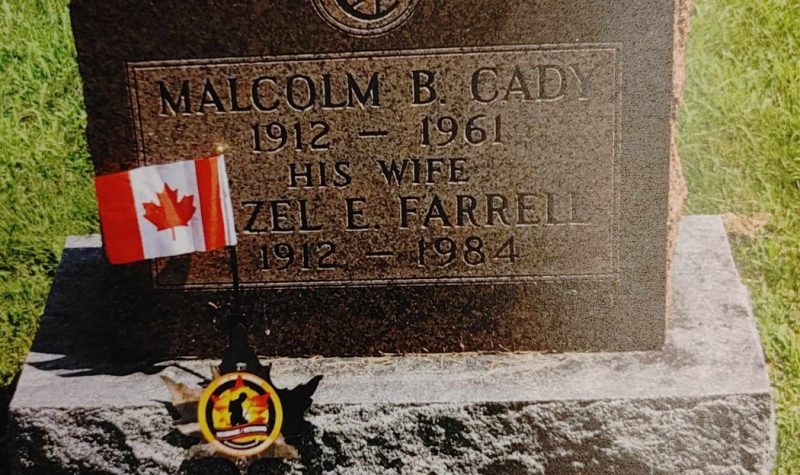A member of the Royal Canadian Legion in Philipsburg Branch #82 has been working on a veteran grave marker project with the goal of expanding it nationwide by next year, hopefully in time for next year's Remembrance Day.
Arnold Raymond has been a volunteer with the Royal Canadian Legion in Philipsburg, Quebec Branch #82 since 2013. Shortly after becoming a member, he discovered that his grandfather served in the Canadian Armed Forces in the First World War. After visiting his gravesite, he decided to create a marker that would clearly identify his grandfather as a veteran.
CIDI sat down with Raymond and Edith Dandenault, a project volunteer, to discuss the veteran grave marker project.
“That was only eight years ago that I learned about this [his grandfather's service] and it’s not right. I think I should have known about that before, and there are a lot of people in my case as well in this country that don’t know. I think the markers should be in the cemetery identifying these people. Whenever anyone goes to a cemetery to visit their loved ones, they’ll see there’s a veteran, there’s a veteran,” said Raymond. “We have over 1300 cemeteries in Quebec alone that have veterans in it that aren’t identified and I think that’s wrong.”
Collaborating with a group of volunteers that hopped on board with his initiative, 220 graves have been marked in Canada since 2018. Now Raymond is looking to bring the project to the next level.
“What we want to do is get the names and addresses of all of the legions across Canada, and by next Remembrance Day send them all a marker, along with a little pamphlet saying ‘offer these to your community, your loved ones, your veterans, your veteran’s families.’ If they want one, they can buy one through that legion and we will ship it to that legion, and they can pick it up at that legion. All of the districts in Canada, we should be able to cover them all. I want this to be a national thing,” he highlighted.
Continuing to highlight his cause, Raymond explained that veterans that serve in the Canadian Armed Forces and die overseas are “all identified with the Common Wealth Grave Commission, but there’s nothing in this country and that’s my goal is to get them all identified.”
“The children today, they don’t know what went on. They’re not aware of who served. It’s to make them aware and to educate them more on the service that our people did and serving our country to give us what we have today. All of the peace and freedom that we have today, we owe them a lot, we owe them an awful lot. We don’t know them, but we certainly owe them,” he emphasized.
“The federal programs across the country are trying to get kids to start thinking about the First World War, the Second World War, what it meant, and even the wars since then. (…) I thought Arnold was right,” added volunteer Edith Dandenault. “Even for me, even if I don’t have a military family, for me to walk into a cemetery anywhere and to see a recognizable marker, something that would say 'this person’s gravestone you are looking at served this country,' (…) I thought that was something that would touch me. But it’s also in line with programming going on in schools. I’m a teacher, so I thought that was a good tie in.”
Describing the grave marker in more detail, Arnold Raymond said that he originally made them out of plastic, but decided to stick with a “stainless steel leaf with a decal that is UV protected, with a steel shaft, and I knotted a Canadian Flag on it.”
The marker also includes a symbol hand-drawn by Raymond.
“I was using the poppy in the beginning, but I was told that I needed permission from different identities, all the way up through to the Dominion of Command, to use the poppy on this. (…) So I sat down with a paper and a pencil and I drew this. It shows a soldier holding his weapon, head down, a banner across the bottom that says ‘veteran’ in both languages, and ‘je me souviens’ and ‘lest we forget’ on top. It is coloured black and yellow and red for the leaf,” he explained.
As for the timeline for the veteran grave marker project, Raymond said that his goal is to have the sample markers in the hands of all Royal Canadian Legion branches in Canada by Nov. 1 of next year.
Dandenault noted that there are also plans to work with their local Member of Parliament to move things along more quickly.
“What we’re going to try to do in the six months is try to work with our local MP to see if there is some way that we can connect it to Veterans [Affairs] Canada. Right now, it’s not connected - it’s a community built initiative. But the idea is to see if maybe it can fit into one of their programs to make it faster. But I think it comes across well that Arnold’s mission is sort of to make sure that it gets it done,” she explained.
“This has got to be done, it’s overdue. It’s long, long, long overdue,” added Raymond.
Those interested in ordering a veteran grave marker can send an email to vetsmemorialmarkers@gmail.com or call 450-538-1500. Veterans include anyone that served in the Canadian Armed Forces, whether in battle or not.
Listen to the full interview with Raymond and Dandenault below:


